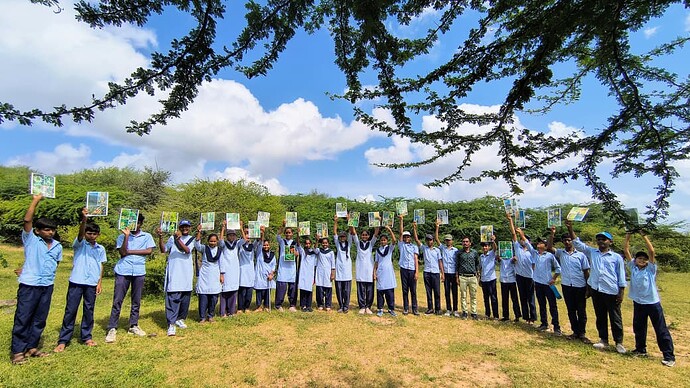Seeing the Forest Differently: Nature Awareness Event at Sangnara Village
Sangnara is a small, vibrant village surrounded by beautiful scrub and thorn forests — the kind that quietly shelters life in every corner. These forests are home to many rare and endangered species, and the people of Sangnara, especially its youth, have long played an important role in protecting this natural heritage.
To deepen this bond between people and nature, a one-day Nature Awareness Event was organized for students of Sangnara High School. After discussions with the sarpanch and village youth, it was decided to engage the younger generation — because they are the ones who will carry forward the responsibility of conserving their village’s rich ecosystems.
A total of 23 students from classes 9 and 10 participated in the event. It began with a short, interactive presentation on the biodiversity and unique ecosystems of Kutch, which set the tone for the day. Afterwards, the students headed to the nearby forest, where a series of interactive games had been designed to make learning exciting and hands-on.
The activities combined fun with deep learning. Students were given plant cards showing photographs, local and scientific names, and traditional uses of native species. They explored the forest, searching for the plants in real life and sharing what they learned with their groups. As they matched the plants to their cards, they began to notice details they had never paid attention to before — shapes of leaves, textures of bark, and the stories hidden in the plants around them.
Sahil, one of the students, summed it up beautifully:
“Ame jungle to pela e roj jota ta, pan aa rite kyarey nathi joyu. Ghas to badhu amara mate ghas j hatu, pan aana etla badha naam ane upyog che e aaje khabar padi.”
(“We used to see this forest every day, but never like this. For us, all grasses were just grass — today we learned they have names, meanings, and uses.”)
The energy and curiosity didn’t stop there. The next game helped them understand how every living being is connected through the food chain. Students acted as grass, rabbits, leopards, and vultures — creating a living food pyramid to show the flow of energy in nature. When one “species” was removed, the entire structure collapsed, helping them realize how fragile and interdependent the web of life really is.
By the end of the day, what began as a fun outdoor activity had turned into something much deeper. The students had not only learned about biodiversity but had also formed an emotional connection with their surroundings. They walked back from the forest talking about plants, animals, and how they now saw their village differently — not just as home, but as part of a living, breathing ecosystem.
The event left behind a sense of pride and responsibility among the students. It reminded them that conservation is not just about protecting nature — it’s about understanding and cherishing the relationships that bind people, land, and life together.

